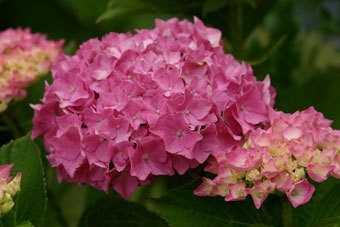
One of the most interesting aspects of growing Bigleaf hydrangeas is the ability to change their color. It isn't easy and it doesn't happen overnight, but if the beautiful pink or blue hydrangea you brought home from the nursery has started to look a little muddy and pale, you can restore its color (or change it) by adjusting the pH of your soil.
The pH scale runs from 1.0 (strongly acid) to 14.0 (strongly alkaline), 7 being neutral. In general, plants grow best in soil with a pH of 6.5-6.8. This range makes for happy worms and microorganisms and generally supports an abundance of readily available soil nutrients. Bigleaf hydrangeas, however, prefer moderately acidic soil with a pH range of 5.0 to 6.4. A soil pH toward the acidic end of the scale (5.0) will change the color of their flowers to blue. On the other hand, a soil pH toward the neutral end of the scale (6.5) will change their flowers to pink. Tip: It takes about 5 pounds of lime per 100 square feet to raise soil pH by 1 point and 2 to 3 pounds of sulfur per 100 square feet to lower soil pH 1 point.
To get a baseline measurement of the pH in your soil, you're going to need a soil test. Inexpensive test kits are available at garden centers, although you'll get more accurate results if you send a sample to a soil testing lab (ask your county extension office). If you decide to send your sample out for testing, be sure to request organic recommendations for adjusting your pH and ask for an explanation of what each amendment will do.
If you're just trying to intensify a color you already have, a soil test may not be necessary. You simply need to make your soil more neutral to darken your pinks or more acidic to intensify your blues. The best time to amend your soil is in the fall after the plants go dormant.
Mother nature intended for white hydrangeas to stay white and no amount of soil amendments can change that. If your hydrangeas are white, enjoy them. They are going to stay that way. Sometimes as white plants age the flowers take on a pinkish tint, but that is about as colorful as white hydrangeas will ever get. The blue and pink Bigleaf hydrangeas like Mophead hydrangeas ( Hydrangea macrophylla) and Lacecap hydrangeas (Hydrangea macrophylla normalis) are what you need to grow if you want to change colors.
For a hydrangea to go from pink to blue, aluminum needs to be present in the soil. In one respect, this sounds easy, because you're adding something to the soil instead of taking something away. Most experts recommend applying it in liquid form by dissolving _ oz (1 Tbsp) of aluminum sulfate in a gallon of water. Plants should be watered well with regular water before applying this solution to avoid possible root burn.
Hydrangeas take up aluminum best in acidic soil, so before you apply aluminum sulfate the pH of your soil should needs to be in the 5.2 to 5.5 range. The aluminum sulfate will then work to lower the soil's pH even further. Organic amendments used to lower soil pH include coffee grounds, fruit peels, lawn clippings, peat moss and pine needles. Fertilizers can change soil pH, too. Bone meal, as well as fertilizers high in phosphorus, should be avoided. Instead, use a fertilizer high in potassium.
If you're starting with blue hydrangeas, your soil naturally contains aluminum and your soil is already more acidic. To change your hydrangeas to pink, you'll need to keep aluminum from becoming available to the plant. One way to do this is to raise the soil's pH by adding dolomitic lime or wood ash several times a year to edge up the scale toward 6.0-6.3. The higher pH will make it more difficult for the hydrangeas to take up any aluminum that is present. Fertilizers high in phosphorus will also help prevent hydrangeas from taking up aluminum.
You may be able to change the color of your hydrangeas, but a pale blue will never turn into a deep red. Intensity is somewhat predetermined by genetics, so if you want to change your pink color to a blue color, expect it to be as pale or intense as the original color.
One of the advantages to growing in containers is that you have complete control over the chemistry of the soil because it's contained. If you have naturally alkaline soil and want to grow blue hydrangeas, you can lower the pH of the soil in a container without negatively affecting nearby plants that prefer more alkaline soil. If you live in an area where blue hydrangeas grow naturally, you may want to consider growing pink hydrangeas in containers in order to easily control the amount of aluminum in the soil.
Weather can also play a role in color intensity, as can plant stress or environmental variables like nearby concrete walls or paths leeching lime. Don't try to change the pH of your soil dramatically over one season. Doing it over the course of several seasons will give beneficial soil organisms time to adapt and you'll get to experience the many shades of color in between your starting point and end results!
About The Author: Ellen Brown is our Green Living and Gardening Expert. Ellen Brown is an environmental writer and photographer and the owner of Sustainable Media, an environmental media company that specializes in helping businesses and organizations promote eco-friendly products and services.
Add your voice! Click below to comment. ThriftyFun is powered by your wisdom!
You can also change the color of a hydrangea buy simply putting rusty nails next to the roots :~)
Add your voice! Click below to comment. ThriftyFun is powered by your wisdom!